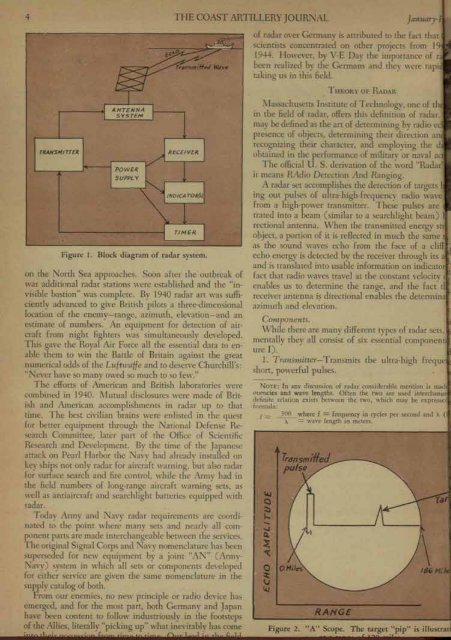January-February - Air Defense Artillery
January-February - Air Defense Artillery
January-February - Air Defense Artillery
Create successful ePaper yourself
Turn your PDF publications into a flip-book with our unique Google optimized e-Paper software.
4<br />
Figure I. Block diagram of radar system.<br />
on the North Sea approaches. Soon after the outbreak of<br />
war additional radar stations were established and the "invisible<br />
bastion" was complete. By 1940 radar art was sufficiently<br />
advanced to give British pilots a three-dimensional<br />
location of the enemy-range, azimuth, elevation-and an<br />
estimate of numbers. An equipment for detection of aircraft<br />
from night fighters was simultaneously developed.<br />
This gave the Royal <strong>Air</strong> Force all the essential data to enable<br />
them to win the Battle of Britain against the great<br />
numerical odds of the Luftwaffe and to deserve Churchill's:<br />
";'\fever have so many owed so much to so few."<br />
The efforts of American and British laboratories were<br />
combined in 1940. 1\ 1utual disclosures were made of British<br />
and American accomplishments in radar up to that<br />
time. The best civilian brains were enlisted in the quest<br />
for better equipment through the National <strong>Defense</strong> Research<br />
Committee, later part of the OfIlce of Scientific<br />
Research and Development. By the time of the Japanese<br />
attack on Pearl Harbor the Navv had alreadv installed on<br />
key ships not only radar for aircr;ft warning, but also radar<br />
for surface search and fire control, while the Armv had in<br />
the field numbers of long-range aircraft warning sets, as<br />
well as antiaircraft and searchlight batteries equipped with<br />
radar.<br />
Toda) Army and Aavy radar requirements are coordinated<br />
to the point where many sets and nearly all component<br />
parts are made interchangeable between the services.<br />
The original Signal Corps and Aavy nomenclature has been<br />
superseded for new equipment by a joint "A:'\" (Army-<br />
:\'avy) system in which all sets or components developed<br />
for either service are given the same nomenclature in the<br />
supply catalog of both.<br />
From our enemies, no new principle or radio device has<br />
emerged, and for the most part, both Germany and Japan<br />
have been content to follow industriously in the footsteps<br />
?f the A.llies, lite~ally "pick~ng up". \-"hat inevitably has come<br />
THE COAST ARTILLERY JOURNAL<br />
of radar over Germanv is attributed to the fact that<br />
scientists concentrated on other projects from 1<br />
1944. Ho\\ ever, b) \'-E Day the importance of r<br />
been realized by the Germans and the\ were rapi<br />
taking us in this field.<br />
THEOR 'I OF RADAR<br />
i\lassachusetts Institute of Technology, one of th<br />
in the field of radar, offers this definition of radar.<br />
may be defined as the art of determining by radio e<br />
presence of objects, determining their direction an<br />
recognizing thelr character, and employing the d<br />
obtained in the performance of military or naval a<br />
The official U. S. derivation of the word "Radar<br />
it means RAdio Detection And Ranging.<br />
A radar set accomplishes the detection of targets<br />
ing out pulses of ultra-high-frequency radio wave<br />
from a high-power transmitter. These pulses are<br />
trated into a beam (similar to a searchlight beam)<br />
rectional antenna. \\Then the transmitted energy s<br />
object, a portion of it is reRected in much the same<br />
as the sound waves echo from the face of a cli<br />
echo energy is detected by the receiver through its<br />
and is translated into usable information on indicato<br />
fact that radio waves travel at the constant velocity<br />
enables us to determine the range, and the fact t<br />
receiver antenna is directional enables the determin<br />
azimuth and elevation.<br />
Compoue1lts.<br />
\Vhile there are many different types of radar sets,<br />
mentally they all consist of six essential component 1<br />
ure I).<br />
1. Tra11Sill itter- Transmits the ultra-high freque<br />
short, powerful pulses.<br />
NOTE: In any discussion of radar considerable mention is mad<br />
l'uPllcies and wave lengths. Often the two are used interchanJ:<br />
delinite relation exists between the two, which may be expresse<br />
inrmula:<br />
f = 300 where f = frequency in cycles per second and X (<br />
~ - = wave length in meters.
















